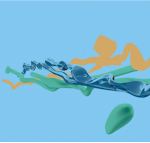Last Friday, the Serious Game Design Summer School came to an end. These two weeks of intensive learning and group work spanned over twenty lectures held on the spot, with around nine or so Skype call-ins coming from industry professionals all over the world. Here is a brief summary of what actually took place in SGDSS '13.
As you probably already know, the first day of the summer school was actually about introductions and easing into what was coming up. The post about the course kick-off can be read here:
http://tamk-artmedia.blogspot.fi/2013/08/serious-game-design-summer-school-kick.html
A rather subjective view on the group task
One of the main things to do during these two weeks was to "found a company" of students to build a serious game and pitch it. The game genre itself could be built around the themes of e-health, sustainability or e-inclusion. In the end, the summer school participants pitched a lot of games about sustainability.
Myself, I ended up in a group with several nationalities; Portuguese, French and Austrian. This cultural mix was encouraged as well, to produce fresh points of view for our games. Naturally, we had also both male and female students in our group.
Our group quickly came up with a name "Space Bananas". The naming also reflects the reason I wanted to join this group in the first place; there seemed to be something crazy about these guys, in the right sense of word. Our brainstorming session on Tuesday lasted until early evening, which furthered my beliefs of being in a very motivated group of individuals. I am sure this was true for the rest of the groups as well.
Each of us had their own job in the group. Our manager, Manuel, had studied engineering before turning into an art student, so he could come up with clear concepts very quickly. Our artist was Ricardo, who studies in the same school as Manuel, in ESAD, Porto, Portugal. The programming horsepower came from France. Tom studies at Epitech in Rennes and specializes in Unity and game-making. On the three-dimensional visuals side, we had two Austrian girls, Manuela and Monika, who had studied the quirks of Cinema 4D in their previous semester, proving to be solid performers in 3D modeling. Myself, I ended up having a job in selecting appropriate sound material for the game. I also kind of tangled myself with writing the group's blog, which you can reach here: http://group3.summerschool.engagelearning.eu/

Lectures
The lectures were scattered around the two weeks, with most of them held on the first week. I found this very reasonable, as working on the group projects intensified incredible amounts til the end, as one can imagine. The lectures also catered to plenty of our questions we might have had in our group projects. We received teachings in storytelling, three-dimensional graphics, user experience design, gender aspects of game design and marketing, to name a few topics.
One of my favorite lectures included Michael Marcondes' lecture about 3D, which he gradually took to higher topics, finally coming to what inspiration actually means. Paul and Maja Pivec also held a "double feature" as they called it, to throw us stereotypes and archetypes of what male and female gamers are like. I found their method of creating cognitive dissonance fascinating and engaging. I was forced to rethink how to do my work properly to send the right messages to my target audience.
The professors also went around our groups while we were working to make notes and discuss the development processes with us. In the latter part of the summer school, while our group was finishing up the prototype, we were visited by Konrad Baumann, who helped make notes on how our user interface could be improved. We found out that rather than mixing different art styles, it might be better to stick with one or two to keep the user interface consistent and easy for the player to understand.
Skype call-ins
In addition to the lectures on the spot at Finlayson, we received call-ins through Skype, that were put out on the big screen. Industry professionals from such companies as Valve and Ovos, gave insight to what could be achieved with game-based learning. An important note was that the so called "scaffolding", or gradually educating the player to learn the concepts in the game, ring true in any type of game. An educational game shouldn't take for granted the mechanics and controls.
We learning over Skype how funding is something that might attract entrepreneurs to serious games. These days, health insurance companies pay game developers and designers and doctors even prescribe games to patients.
Pitches & the end
After one and a half week of work, our game prototype was to be pitched. The pitches were made in pecha kucha -fashion, giving performers six minutes and forty seconds to be on stage. Our sustainability-themed game concept about a box in the search of his lost cat friend got generous applause. Students were to vote also if they would download & play the pitched games and if they would even go so far as pay for them. I was also happy to see school staff & other students coming in to see our pitches.
Once the pitches were done, the groups were to turn in the design documents in the next 24 hours. We also received feedback on our performances on Friday from all the teachers and ideas on how to continue with the projects.
Overall, Serious Game Design Summer School was an amazing experience and I got just what I was looking for; insights to making games with a serious underlying message and working with extremely talented and motivated people. Goodbyes were exchanged but somehow I feel I will bump into at least my group members somewhere later in life. Thank you!

 Suomeksi
Suomeksi













